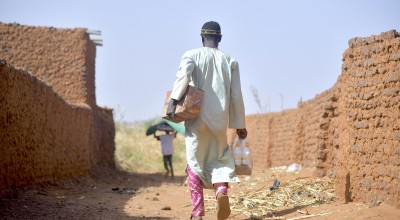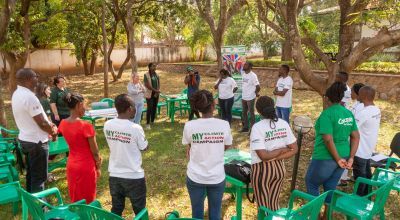
Read our 2024 annual report

Knowledge Hub
Malawi is suffering some of the worst impacts of climate change, despite being one of the countries least responsible for it. In an effort to combat this threat, Malawians are turning to innovative agriculture techniques to protect their farms, food supplies and incomes.
The situation in Malawi

Cyclone Freddy began battering southern Malawi on March 12, with around a month’s rain falling in just 24 hours and the torrential rains resulting in floods and mudslides in 14 of Malawi’s 28 districts. Having lasted for 35 days, it is the most powerful cyclone ever recorded in the Southern Hemisphere, and it is likely to be the longest cyclone ever recorded.
Close to 120,000 hectares of farmland were destroyed, along with homes and hospitals. Over 500 people were killed, while more than 500,000 people were displaced by the floods. Many of these displaced people are now living in camps, 576 of which have been established across Malawi. However, in these crowded and cramped situations, teamed with a lack of clean water, there is the potential for an outbreak of cholera. The latest outbreak of cholera in the country has already claimed more than 1,660 lives in Malawi, and with the lean season potentially leading to malnutrition, there are fears that this could lead to child mortality, as a severely malnourished child is 11 times more likely to die from cholera than a well-nourished one.

About four million people — a fifth of Malawi’s population — were already facing food insecurity prior to Cyclone Freddy, but with farmland being destroyed, many, many more will be in need of assistance. Even before considering the toll taken by Cyclone Freddy, this year’s harvest was already expected to be below average, due to the rising costs of fertiliser and poor rainfall. This is a continuing trend — in the 2021/2022 farming year, Malawi's maize output declined by 18.9%, due to a combination of factors including drought, cyclones and inadequate supply of fertilizer; the previous season saw maize production fall from 4.6 million metric tonnes to 3.7 million (as per the Agricultural Production Estimate Survey).
Cyclone Freddy was another vicious blow to Malawi, which had been recovering from the impact of two cyclones in 2022. In January, more than 900,000 people were affected by Tropical Storm Ana, which caused damage in the Mulanje region and affected the country’s electricity supply. Just two months later, Malawi was hit by Cyclone Gombe, with rainfall causing heavy damage in 10 districts and seven deaths being reported. Malawi was also at the epicentre of 2019’s Cyclone Idai, which United Nations Secretary General António Guterres called “one of the worst weather-related catastrophes in the history of Africa”.
Why Malawi is so vulnerable to climate shocks
These cyclones would be destructive to any country, but for Malawi, the effects are even more devastating. Malawi is one of the top 10 countries in the world most affected by climate change.
Malawi is a densely populated and landlocked country in the south-east of Africa that is home to 19 million people — over 80% of those are living in rural communities. Agriculture employs 80% of the population, with many families relying on subsistence farming — that is, growing just enough food to meet their own needs — to put food on the table. This means that when harvests fail, people go hungry. It is estimated that 20% of the population, around 3.8 million people, need food aid during the October to March lean season.
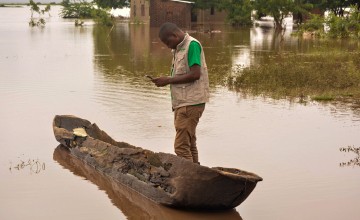
So when climate shocks like droughts and floods occur, the situation deteriorates. Both droughts and floods can decimate crops and severely damage soil, ruining farmers’ chances of a strong harvest. Farmers had been preparing their land for the April harvest when Cyclone Freddy struck, causing huge uncertainty for those depending on their crops to feed their families and generate an income. And without an income from produce, it can be difficult to afford the soaring prices of staple foods and fuel.
Sadly, droughts and floods have increased in frequency and magnitude over the past twenty years, with consequences for the livelihoods and securities of rural communities.
Climate smart agriculture
So what is the solution? The creation of a loss and damage fund, agreed on by world leaders at COP27, is vital to support the world’s poorest countries who are experiencing the worst impact of climate change, despite being the least responsible for it. But beyond that, it is crucial that we adapt to climate change — that is, taking action to prepare for and adjust to the current effects of climate change and the predicted impacts in the future.
Part of this is the promotion of Climate Smart Agriculture (CSA), which is a core part of Concern Worldwide’s resilience strategy across many of the countries in which we work.
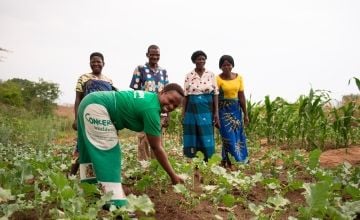
This type of conservation agriculture is a set of farming practices that helps people to get the highest possible yield from their crops in challenging weather conditions. An example of this is using organic fertilisers. The price of chemical fertilisers has shot up, in part due to the conflict in Ukraine, and transport issues have resulted in a worldwide shortage. This is bad news for Malawi, which is largely dependent on imported fertiliser to grow crops. However, in the long-term, these chemicals deplete the soil’s nutrients, and more fertiliser is then required each year to produce the same yield — a vicious circle.
Organic fertilisers are more sustainable, and improve soil structure, so farmers experience less crop failure during dry spells.
Climate smart agriculture in action
In Samu village, Neno District, Foster Kalipande, 24, and Annie Yohane, 28, grew gliricidia in their nursery, in order to restore soil fertility in their land. The leaf of gliricidia, a rapidly growing thornless tree, can be used for fertiliser, which leads to higher crop productivity and yields. Due to its strength, it can also be used as a sort of living fence, as a support tree for different crops such as sweet potatoes and peppers.
Annie explained: “We are doing this so we can restore the soil fertility in our farms and protect the area against the effects of climate change.”

Another method of fertilising the soil involves using maize bran and animal dung to make what is called Mbeya fertiliser. Not only is it quick to make, it is a cheap and sustainable alternative to more expensive chemical fertilisers. Small amounts can also be added to existing fertilisers to stretch out what farmers have cheaply, from resources they have access to.
The Sayamika Conservation Catchment Group in Samu village are among the groups using CSA methods to protect the Sayamika River and the surrounding fields. Farmer Kosimasi Salijeni, 37, explained that he is now able to harvest crops several times a year since adopting new farming methods and receiving necessary tools, such as hoes, watering cans and wheelbarrows, from Concern, and shared that everything in their farming is now connected.
We are not devastating the environment, we are busy taking care of the environment
He said: “Because we put manure in the pond, the water has nutrients which are applied in the uplands. In the uplands we harvest crops like maize. When we remove the maize bran, we use it to make fish feed. We make the feed for the fish by taking some of the small fish, drying them. We also use maize, soya, flour and cooking oil. They are the ingredients we use to make the feed for the fish. With this feed, we can feed the fish for six months. It is a big fish after six months, which customers at the market appreciate.
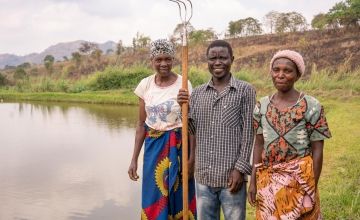
“Everything is connected. We are using the fish pond to irrigate our crops on the land, and we are using the same fish to make the feed for the fish. We are not devastating the environment, we are busy taking care of the environment.”
Embracing technology
Malawian farmers are also embracing new technologies to improve their practices. In Mkulira village in Mwanza, the Titukuke Irrigation Scheme group applied for a solar pump from Concern, which they have since received. The farmers used to irrigate their land by hand, using water buckets and cans; a process which was extremely tiring and labour and time intensive. However, now, they can use their solar pump for up to three hours at a time, making short work of irrigation and allowing farmers to spend their time on other activities.
Farmer Mcfreson Aaron, 33, explained: “There is hope that we are going to differentiate with how we used to harvest in the past and now. There can be more harvests as compared to how much we used to harvest in the past. We will obtain more harvests. Why is it so? Because we have cultivated a large area while when we are using water buckets, we cultivate a small piece, as compared to the entire land. This solar pump has helped to change our households.”
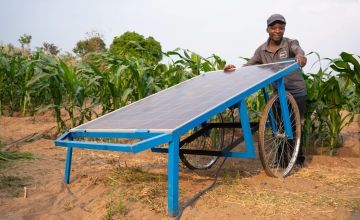
And it’s not just farmers who are benefitting from new climate smart technologies. The National Youth Network on Climate Change (NYNCC) in Lilongwe told us about the rise in the use of biogas, a sustainable energy that uses a digester to convert organic matter - food waste, animal waste, farm waste, and even human waste - into energy. It’s complicated, but the digester system is like a compost bin that all organic waste is disposed of into. The waste is submerged in water, which creates an environment that allows bacteria to break down the waste into methane. This methane is converted into cooking gas, while the waste can also be used for fertiliser.
We cannot fight the effects of climate change that are already occurring, but we can use everything in our power to adapt and make ourselves and our practices more sustainable for the future. Whether it’s reducing our carbon footprints in the Global North, or providing training on CSA methods in the Global South, we can support those most affected by climate change.
Follow us on Instagram for updates



